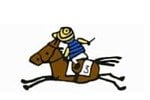-
 The race name comes from the original prize-money – a guinea amounted to £1.05 or 21 shillings. It is the second of the five Classic races held in Britain and is one of two restricted to fillies. The 200th QIPCO 1000 Guineas this year is worth £400,000 in prize-money.
The race name comes from the original prize-money – a guinea amounted to £1.05 or 21 shillings. It is the second of the five Classic races held in Britain and is one of two restricted to fillies. The 200th QIPCO 1000 Guineas this year is worth £400,000 in prize-money. - The first 1000 Guineas was run on 29 April 1814, five years after the first 2000 Guineas which is open to both colts and fillies.
- The first winner of the race was called Charlotte who defeated four other fillies. She was returned at odds of 11/5 and her jockey’s silks were light blue with a black trim and a black cap.
- The race was set up by The Jockey Club under Sir Charles Bunbury who had earlier been involved in establishing The Derby on Epsom Downs.
- The 1000 Guineas in 1945 was held on VE Day – 8 May – and attracted a big and jubilant crowd.
- The fastest winning time was that of Ghanaati in 2009 – 1 minute 34.22 seconds.
- The widest winning margin was 20 lengths, by Mayonaise in 1859.
- The shortest-priced winner was Crucifix (1/10) in 1840; the longest-priced winner was Ferry (50/1) in 1918.
- The largest field of runners was 29 in 1926; the smallest was just one – Tontine who won in a walkover – in 1825.
- The most successful current jockey, with four wins in the race, is Kieren Fallon, followed by Frankie Dettori on three. The rider with most winners ever was Cambridge-born George Fordham with seven between 1859 and 1883.
- The most successful current trainer, with six wins in the race, is Sir Henry Cecil, although it is 14 years since his last victory. The trainer with the most winners ever was Robert Robson with nine between 1818 and 1827.
- The Queen owned the winner of the race in 1974 – Highclere – her third Classic success at the time. Her grandfather, King George V, had won the race in 1928 with Scuttle, his first Classic winner.
- The Queen’s father, King George VI, triumphed twice, with Sun Chariot in 1942 and Hypericum in 1946. The latter won despite having initially thrown her jockey off and run into a car park.
- The 1975 race was delayed because of a ‘sit-in’ on the racecourse by stable lads who were on strike in a pay dispute. While the Guineas races were run, the industrial action caused the French Oaks to be abandoned and there were pickets at Royal Ascot.
- The 1985 winner Oh So Sharp went on to complete the fillies’ ‘Triple Crown’ of 1000 Guineas, Oaks and St Leger. Formosa, in 1868, was the first filly ever to achieve the ‘Triple Crown’.
Guide to the Guineas Festival 2013 – CLICK HERE
Allison is the Publisher of Eclipse Magazine. She loves going to the Races and is learning to bet (despite being officially the worst bettor in the History of the Universe), there’s a lot more to learn…



